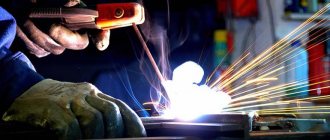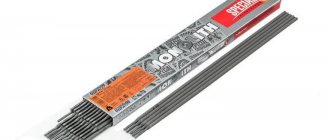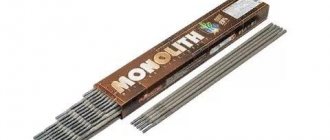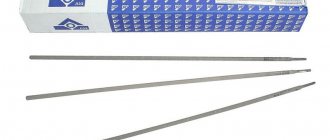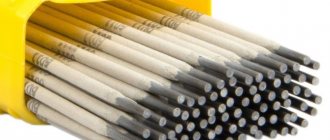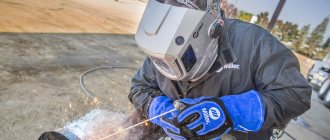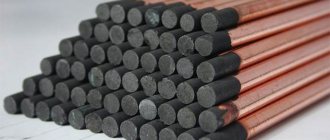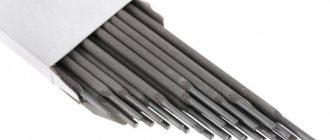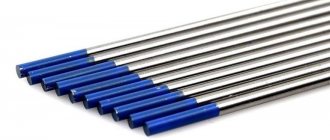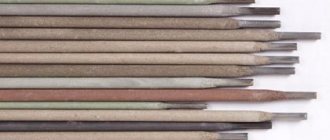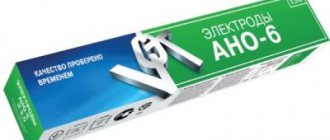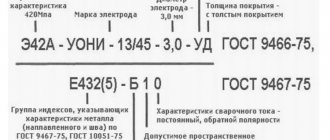Type E50A is standardized by GOST 9467-75 for use in critical products made of carbon and low-alloy steel that are to be operated in conditions of low and high temperatures, such as 10KhNDP, 15KhSND and 10KhSND.
Seams with such material have greater ductility and toughness under impact. Certified electrodes of this type are used in shipbuilding, energy and nuclear industries.
This type includes brands : OZS-18, OZS-25, E-138/50N, ANO-TM, DSK-50U, TMU-21U, TMU-50, MTG-02, MTG-01K, TsU-5, TsU- 5M.
All Russian-made electrode brands listed here are interchangeable. In their manufacture, welding wire Sv-08 or Sv-08A is used. Coverage is, in most cases, basic. Thus, the same chemical composition is formed during welding.
The difference in brand names is explained by the fact that the electrodes are produced by different companies and may have some differences related to areas of application (for example, for pipes or resistance to cracks in the cold, etc.).
They, of course, have slight differences in their composition and coating thickness, but since the composition of the welding wire and coating is regulated by standards (GOST 2246-70 for wire), the welding result will be very close, all other things being equal. The composition of the coating has more influence on the welding technology than on the chemistry of the seam.
Quality certification
Certificates for electrodes are required for critical work. If a consumer is building a garage for himself, then it is extremely unlikely that anything will happen to him, the loads on the seams are too insignificant. If it does happen, the consequences will be minor, at least compared to other possible uses. If the welding material is used for work in industry, shipbuilding, gas or oil pipelines, or nuclear energy, then the consequences of poor welding can take on catastrophic proportions.
A certificate is a document that confirms the quality of the electrodes and the responsibility of the issuing party for everything that may happen. For example, in the case of a maritime disaster, a court may find that it was due to poor welding associated with poor quality electrodes. At the same time, the electrodes were issued a Lloyd's Register of Shipping certificate. In this case, Lloyd will pay the owners of the ship, cargo or relatives of passengers.
Another thing is that knowing this, Lloyd's Register will not simply issue its certificate, but will require confirmation of product quality from the most authoritative experts. The certificate may have a limited validity period and require confirmation. Therefore, a responsible consumer, regardless of whether we are talking about a Russian or international certificate, should pay attention to its validity period.
All enterprises that produce electrodes of the E50A type issue certificates for them, since the field of application of the material covers critical metal structures and, basically, these electrodes are used for these purposes.
General concept of E50A type electrodes
Products of the E50A brand are intended for joining flat and profiled parts made of structural steels and materials with a small percentage of alloying elements. The seams meet increased requirements for impact strength and ductility, the tool allows welding work in any position when supplying direct current with reverse switching polarity (the negative pole of the equipment is connected to the workpiece). Welding on vertical planes in the direction from top to bottom is not allowed.
In accordance with the standard, preliminary mechanical cleaning of the mating edges from dirt and rust is required; traces of oil must be washed off with organic volatile solvents.
Welding is performed with a short arc; to improve the quality of the seam, it is recommended to calcinate the electrodes in an electric furnace with a thermometer and a heating regulator for 60 minutes at a temperature of +325°...+375°C.
Advantages of using electrodes:
- ease of excitation and stable combustion of the arc discharge;
- reduced level of metal spattering (if the technology is followed);
- increased resistance of the deposited metal to the formation of crystallization cracks;
- suitability for welding parts operating under alternating cyclic loads;
- reduced content of impurities in the weld material.
Specifications
The outer surface of the metal rod has a monolithic coating of the basic type made of carbonates and fluorine-based compounds. When an electric arc burns, the outer layer melts and protects the melt from the penetration of gases and non-metallic compounds.
We recommend reading Description of E42 electrodes for welding
E50A electrodes have a monolithic carbonate coating.
The disadvantage of the base coating is the sensitivity to rust on the parts being connected when the surface is moistened and the arc discharge is prolonged.
No other coatings are used for E50A electrodes.
Main parameters:
- deposition factor – 9.5 g/A*h;
- average material consumption to obtain 1 kg of deposited steel is 1.5 kg;
- tensile strength of the resulting seam – 530 MPa;
- impact strength at +20°C and -50°C – 140 and 34 J/cm², respectively.
The resulting layer of deposited metal has the following chemical composition:
- carbon – no more than 0.1%
- manganese – from 0.9 to 1.4%;
- silicon – from 0.25 to 0.5%;
- sulfur – not higher than 0.03%;
- phosphorus – no more than 0.03%.
Manufacturers produce round electrodes with a diameter of 2 to 6 millimeters; the current strength during welding depends on the position of the seam and the cross-section of the tool. For example, for a size of 2 mm and a horizontal joint line, it is necessary to supply 40-80 A; for a ceiling location, the upper limit is reduced to 70 A (to reduce the risk of melt leaking out of the gap between the parts). Electrodes are supplied to customers packaged in packs weighing from 1 to 5 kg with a thick paper shell that prevents the negative effects of atmospheric air.
Explanation of type designation E50A
- The letter E in the designation means that the material refers to manual welding electrodes.
- The number 50 means the tensile strength of the weld, rounded in kilograms, per square millimeter of cross-section of the deposited metal. This allows you to calculate the load for tensile joints, which is very important when calculating trusses.
- The letter A means that the plasticity of the seam and its toughness have increased values.
general information
E50a electrodes are intended for welding particularly critical metal structures made of carbon steel with a low content of alloying elements in the composition. The resulting seams are designed for use in conditions of high and low temperatures. The compounds are plastic and viscous. This characteristic is especially evident during mechanical shocks. Most often, electrodes of this type are used in shipbuilding, as well as in the nuclear industry.
Decoding
E50A is not just a set of numbers and letters. This is a name with information encrypted in it.
The letter “E” indicates that this type of electrode is intended for manual arc welding with coated electrodes. The numbers 5 and 0 are the tensile strength value. Using this number, you can calculate the loads that the seam can withstand. And this is extremely important when welding load-bearing structures. For example, farms. The letter “A” indicates that the finished seam will have increased ductility and viscosity.
Electrode brands
Type E50A includes brands TMU-50, MTG-02, MTG-01K, TsU-5, OZS-18, ANO-TM, TsU-5M, DSK-50U, TMU-21U, OZS-25, E-138/50N .. These are commonly used brands. In fact, there are many more of them.
These brands are domestically produced and have similar characteristics. Each brand is based on either Sv-08 or Sv-08A wire. In most cases, the coverage is basic. Therefore, the chemical composition of all these brands is similar. Choose the one that suits your price and that you can easily buy at your nearest store.
These electrodes have different names but have relatively the same composition. This is due to manufacturers who develop their brands and name them in accordance with their classification principles. But. Despite the differences in name, the chemical composition remains the same. So the result will be approximately the same, no matter which brand you choose.
Peculiarities
Some features of the E50A may depend on the brand. For example, OZS-28 allows any position of the seam, while the rest exclude vertical in the direction from top to bottom. Some brands can operate on alternating and direct currents: UONI-13/55T, OZS-28, OZS-33; and others only on constant, reverse polarity: UONI-13/55, UONI-13/55G, OZS-18, OZS-25, OZS-29, TMU-21U.
The vast majority of materials of type E50A have a base coating. It consists of calcium and magnesium carbonates, with the addition of fluorspar. When carbonates decompose, they release carbon oxides, which are partly a reducing agent due to CO, but otherwise create a protective environment of carbon dioxide. The same processes continue until the slag hardens.
The electrodes must operate on a short arc - fluorine is very difficult to ionize. The polarity on the electrode should be positive and the current constant , all this is done to improve arc burning. In addition, the coating is very hygroscopic, absorbs moisture and this does not contribute to a good arc.
NOTE: Before use, be sure to dry the electrodes in an oven at a temperature of 350-400°C for an hour. After such calcination, the electrodes are good for no more than 3-5 days. A total of up to 3 calcinations are allowed, after which the quality of the coating decreases and it may collapse.
Characteristics
Electrodes of this type have increased strength characteristics. The coating of the internal rods helps to counteract oxidation and the presence of foreign impurities in the weld metal that have a harmful effect.
The benefits of use include:
- Stable arc combustion and ease of initiation.
- Slight spattering of metal during welding.
- Resistance of weld metal to cracking.
- Ability to work under different loads.
- Reduced content of foreign impurities in the weld metal.
However, there is a limitation on application. Stainless steel products cannot be welded with such electrodes. Welding must be done with a short arc. Its lengthening will lead to a significant deterioration in the result and difficulties during the welding process.
The set current strength depends on the spatial position and diameter of the electrode. Different models have slight differences that should be taken into account. For example, electrodes of the OZS-28 brand from this series can be used in all positions, while other types eliminate the downward movement of the electrode from the upper position. It is also necessary to keep track of what type of current is recommended when using a particular brand.
Certification
Welding electrodes must be of sufficient quality so that the structures being welded can withstand the loads applied to them. In the event of technical accidents, damage occurs, at least material, the amount of which can significantly exceed the cost of the product in which poor-quality welding was used. This leads to all sorts of legal proceedings, during which examinations are ordered.
Experts may point to poor welding as the cause, which leads to the welder, his equipment and electrodes. If a welder is required to have a certificate with a discharge, and his machine must only produce the required type and magnitude of current, then with electrodes everything is more complicated. Externally, bad and good electrodes may not differ. The quality of the electrode depends on the wire used in it, its chemical composition, and the composition of the coating. All this is determined using chemical tests that require special equipment.
To minimize the number of examinations, samples of electrodes produced by the enterprise using the same technology and from the same materials are tested. If the material passes these tests, then it receives a certificate (suitability, compliance, etc.). This document says about the material for which it is issued, what specific requirements it satisfies, directly or provides reference to standards, specifications, and so on, in what areas or industries it can be used. The validity period of the certificate is indicated, and finally, the name of the organization that issued it.
Examples of certifying organizations: GOST R, River and Sea Registers of the Russian Federation (for the use of electrodes in shipbuilding and repair), NAKS (National Welding Control Agency), EASC (Eurasian Welding Certification Community) and others.
Electrode marking
Marking of electrodes for welding contains information about the type, brand, diameter and other characteristics:
Electrodes for welding LEZANO-21
Marking of electrodes for welding LEZANO-21
1 - electrode type: E46
— for welding carbon and low-alloy steels with tensile strength up to 46 kgf/mm2;
2 — electrode brand: LEZANO-21
;
3 - electrode diameter: indicated elsewhere; 4 - purpose of the electrode: U
- for welding carbon and low-alloy steels with tensile strength up to 588 MPa (60 kgf/mm2);
5 - coating thickness coefficient: D
- with a thick coating (1.45 6 - international designation of a consumable coated electrode:
E
; 7 - tensile strength:
43
- 430 MPa (44 kgf/mm2); 8 - relative elongation:
1
- 20%; 9 - minimum temperature at which the impact strength of the weld metal is at least 34 J/cm2 (3.5 kgf m/cm2):
3
- -20°C; 10 - type of coating:
RC
- rutile-cellulose; 11 - permissible spatial positions:
1
- for all positions; 12 - welding current and open circuit voltage:
3
- welding with alternating current and direct current of reverse polarity, open circuit voltage about 50V.
Decoding the marking of electrodes for welding ANO-21
1 - electrode type: E46
— for welding carbon and low-alloy steels with tensile strength up to 46 kgf/mm2;
2 — electrode brand: ANO-21
;
3 — electrode diameter: 2.5
mm;
4 - purpose of the electrode: U
- for welding carbon and low-alloy steels with tensile strength up to 588 MPa (60 kgf/mm2);
5 - coating thickness coefficient: D
- with a thick coating (1.45 6 - international designation of a consumable coated electrode:
E
; 7 - tensile strength:
43
- 430 MPa (44 kgf/mm2); 8 - relative elongation:
0
- less than 20%; 9 - minimum temperature at which the impact strength of the weld metal is at least 34 J/cm2 (3.5 kgf m/cm2):
3
- -20°C; 10 - type of coating:
R
- rutile; 11 - permissible spatial positions:
1
- for all positions; 12 - welding current and open circuit voltage:
1
- welding with alternating current and direct current of any polarity, open circuit voltage about 50V.
Designation of electrodes for welding MP-3 PLASMA
1 - electrode type: E46
— for welding carbon and low-alloy steels with tensile strength up to 46 kgf/mm2;
2 — brand of electrode: MP-3 PLASMA
;
3 - electrode diameter: indicated elsewhere; 4 - purpose of the electrode: U
- for welding carbon and low-alloy steels with tensile strength up to 588 MPa (60 kgf/mm2);
5 - coating thickness coefficient: D
- with a thick coating (1.45 6 - international designation of a consumable coated electrode:
E
; 7 - tensile strength:
43
- 430 MPa (44 kgf/mm2); 8 - relative elongation:
0
- less than 20%; 9 - minimum temperature at which the impact strength of the weld metal is at least 34 J/cm2 (3.5 kgf m/cm2):
3
- -20°C; 10 - type of coating:
R
- rutile; 11 — permissible spatial positions:
2
— for all positions except vertical “top-down”; 12 — welding current and open-circuit voltage:
6
— welding with alternating current and direct current of reverse polarity, open-circuit voltage about 70V.
Marking of electrodes for welding UONI-13/55
1 - electrode type: E50A
— for welding carbon and low-alloy steels with a tensile strength of 50 kgf/mm2, “
A
” indicates that the weld metal has increased properties of ductility and impact toughness;
2 — electrode brand: UONI-13/55
;
3 — electrode diameter: 5.0
mm;
4 - purpose of the electrode: U
- for welding carbon and low-alloy steels with tensile strength up to 588 MPa (60 kgf/mm2);
5 - coating thickness coefficient: D
- with a thick coating (1.45 6 - international designation of a consumable coated electrode:
E
; 7 - tensile strength:
51
- 510 MPa (52 kgf/mm2); 8 - relative elongation:
4
- 20%; 9 - minimum temperature at which the impact strength of the weld metal is at least 34 J/cm2 (3.5 kgf m/cm2):
4
- -30°C; 10 - type of coating:
B
- main; 11 - permissible spatial positions:
2
- for all positions except vertical “top-down”; 12 - welding current:
0
- direct current welding of reverse polarity.
Designation of electrodes for welding TsL-11
1 — electrode type: E-08Х20Н9Г2Б
— for welding high-alloy steels;
2 — brand of electrode: TsL
(the brand is abbreviated, the brand TsL-11 is indicated elsewhere);
3 - electrode diameter: indicated elsewhere; 4 - purpose of the electrode: B
- for welding high-alloy steels with special properties;
5 - coating thickness coefficient: D
- with a thick coating (1.45 6 - international designation of a consumable coated electrode:
E
; 7 - test method for the resistance of weld metal to intergranular corrosion:
2
- AM and AMU; 8 - maximum operating temperature at which indicators of long-term strength of the weld metal (heat resistance) are regulated:
0
- no information; 9 - maximum operating temperature of welded joints:
0
- no information; 10 - ferrite phase content in the weld metal:
5
- 2.0-10%; 11 - type of coating :
B
- basic; 12 - permissible spatial positions:
2
- for all positions except vertical “top to bottom”; 13 - welding current:
0
- direct current welding of reverse polarity.
Electrode type
For welding carbon and low-alloy steels, as well as alloyed steels with increased and high strength, the marking consists of:
- index E
- electrode for manual arc welding and surfacing; - numbers following the index indicating the value of tensile strength in kgf/mm2;
- index A
, indicating that the weld metal has increased properties of ductility and impact toughness.
For welding heat-resistant, high-alloy steels and for surfacing, the symbol consists of:
- index E
- electrode for manual arc welding and surfacing; - hyphen;
- the number following the index indicating the average carbon content in hundredths of a percent;
- letters and numbers indicating the percentage of chemical elements. The order of arrangement of letter designations of chemical elements is determined by a decrease in the average content of the corresponding elements in the deposited metal. If the average content of the main chemical element is less than 1.5%, the number behind the letter designation of the chemical element is not indicated. If the average content of silicon in the deposited metal is up to 0.8% and manganese up to 1.0%, the letters C and G are not affixed.
Designation of metals
For welding carbon and low-alloy steels with tensile strength up to 490 MPa (50 kgf/mm2), 7 types of electrodes are used: E38, E42, E46, E50, E42A, E46A, E50A. For welding carbon and low-alloy steels with tensile strength from 490 MPa (50 kgf/mm2) to 588 MPa (60 kgf/mm2), 2 types of electrodes are used: E55, E60. For welding alloy steels of increased and high strength with a tensile strength over 588 MPa (60 kgf/mm2), 5 types of electrodes are used: E70, E85, E100, E125, E150.
For welding heat-resistant steels - 9 types: E-09M, E-09MH, E-09H1M, E-05H2M, E-09H2M1, E-09H1MF, E-10H1MNBF, E-10H3M1BF, E10H5MF. For welding high-alloy steels with special properties - 49 types: E-12Kh13, E-06Kh13N, E-10Kh17T, E-12Kh11NMF, E-12Kh11NVMF, etc. For surfacing surface layers with special properties - 44 types: E-10G2, E- 10G3, E-12G4, E-15G5, E-16G2KhM, E-30G2KhM, etc.
Electrode brand
Each type of electrode may correspond to one or more brands.
Electrode diameter
The diameter of the electrode (mm) corresponds to the diameter of the metal rod.
Purpose of the electrode
- For welding carbon and low-alloy steels with tensile strength up to 588 MPa (60 kgf/mm2) - marked with the letter U
; - For welding alloyed structural steels with tensile strength over 588 MPa (60 kgf/mm2) - marked with the letter L
; - For welding heat-resistant steels - marked with the letter T
; - For welding high-alloy steels with special properties - indicated by the letter B
; - For surfacing surface layers with special properties - marked with the
letter N.
Coating thickness coefficient
Depending on the ratio of the electrode coating diameter D
to the diameter of the metal rod
d
, electrodes are divided into the following groups:
- with a thin coating (D/d≤1.2) - marked with the letter M
; - with medium coverage (1.2 C
; - with a thick coating (1.45 D
; -
d >1.8) - G.
Designation of consumable coated electrode
Letter E
— international designation of a consumable coated electrode.
A group of indices indicating the characteristics of the weld metal or deposited metal
For electrodes used for welding carbon and low-alloy steels with tensile strength up to 588 MPa (60 kgf/mm2).
Characteristics of weld metal electrodes for welding carbon and low-alloy steels with tensile strength up to 588 MPa
In the designation of electrodes for welding alloy steels with tensile strength over 588 MPa (60 kgf/mm2), the first index of a two-digit number corresponds to the average carbon content in the weld in hundredths of a percent; subsequent indices of letters and numbers show the percentage of elements in the weld metal; the last digital index, indicated by a hyphen, characterizes the minimum temperature at which the impact strength of the weld metal is at least 34 J/cm2 (3.5 kgf m/cm2). For example, E-12Х2Г2-3
means 0.12% carbon, 2% chromium, 2% manganese in the weld metal and at -20°C has an impact strength of 34 J/cm2 (3.5 kgf m/cm2).
Characteristics of weld metal electrodes for welding alloy steels with tensile strength over 588 MPa
The symbol for electrodes for welding heat-resistant steels contains two indices: the first indicates the minimum temperature at which the impact strength of the weld metal is at least 34 J/cm2 (3.5 kgf m/cm2); the second index is the maximum temperature at which the long-term strength of the weld metal is regulated.
Characteristics of weld metal electrodes for welding heat-resistant steels
Electrodes for welding high-alloy steels are coded by a group of indices consisting of three or four digits:
- the first index characterizes the resistance of the weld metal to intergranular corrosion;
- the second indicates the maximum operating temperature at which the long-term strength of the weld metal (heat resistance) is regulated;
- the third index indicates the maximum operating temperature of welded joints, up to which the use of electrodes when welding heat-resistant steels is allowed;
- the fourth index indicates the content of the ferrite phase in the weld metal.
Characteristics of weld metal electrodes for welding high-alloy steels
The symbol for electrodes for surfacing surface layers consists of two parts. The first index indicates the average hardness of the deposited metal and is expressed as a fraction: the numerator is Vickers hardness, the denominator is Rockwell hardness.
Characteristics of deposited metal electrodes for surfacing surface layers
The second index indicates that the hardness of the deposited metal is ensured: without heat treatment after surfacing - 1
, after heat treatment -
2
.
For example: E-300/32-1
— hardness of the deposited layer without heat treatment.
Designation of the type of coating
- A
- acid coating; - B
- main coating; - C
- cellulose coating; - R
- rutile coating; - AR
,
RB
,
RC
, etc. - mixed coatings - respectively: acid-rutile, rutile-basic, rutile-cellulose; - P
- others.
If there is more than 20% iron powder in the coating, the letter Z
, for example,
AJ
.
There is an article about electrode coatings: Coating of welding electrodes.
Designation of permissible spatial positions
- 1
- for all positions. - 2
- for all positions except vertical “top-down”. - 3
- for the bottom, horizontal on a vertical plane and vertical “bottom-up”. - 4
- for the bottom and bottom for corner connections.
More often, the international designation of the seam positions for which the electrodes are intended is used.
International designation of seam positions and interpretation
Designation of the characteristics of welding current and open circuit voltage of the power source
Characteristics of welding current and open circuit voltage of the power source
In numbers 0
designate electrodes intended for welding or surfacing only with direct current of reverse polarity.
When using the content of this site, you need to put active links to this site, visible to users and search robots.
Literature
Explanation of the symbol
Marking on packaging, in design and other technical documentation consists of letters and numbers that store information about the properties and characteristics of the product:
| E50A - TsU-5 - 2.5 - UD GOST 9466-75 |
| E413(0) - B20 GOST 9467-75 |
Where:
E50A - type of electrode and its strength (500 MPa);
TsU-5 - brand;
2.5 - diameter indicated in mm;
U - for connecting structural elements made of low-alloy and carbon steels;
D - thick coating;
GOST 9466-75 is the name of the Russian standard;
E413(0) - indices that together indicate strength characteristics, in accordance with the requirements of GOST 9467-75;
B - main coating;
2 - in all positions except vertical, carried out from top to bottom;
0 1 direct current of reverse polarity;
GOST 9467-75 is the name of the Russian standard.
